Teachable Moments in News Media—An Analysis of Audience Awareness, Enjoyment, Interest, Opinion Formation, and Understanding (AEIOU) toward Science
Abstract
1. Introduction
2. Theoretical Framework of the AEIOU Approach for “Science Edu-Communication”
- Do SEC-initiated news videos have an effect on audiences’ attitudes toward science (AEIU)?
- As audiences possess different levels of scientific literacy (high/low) in media, do SEC-initiated news videos have an effect on audiences’ attitudes toward science (AEIU)?
- Do SEC-initiated news videos have an effect on audiences’ “opinion formation” (O)?
3. Research Methodology
Participants
4. Materials
4.1. SEC-Initiated News Video
4.2. Scale for SEC-AEIOU
4.3. Scientific Literacy in Media (SLiM) Test
5. Procedure
6. Results
6.1. The AEIU Results of the Two-Way ANOVA
6.2. The Opinion Results from the Coding Analysis and Chi-Square Test
7. Discussion
8. Conclusions and Implementation
Author Contributions
Funding
Conflicts of Interest
References
- Nielsen. Total Audience Report 2019; Nielsen: New York, NY, USA, 2019. [Google Scholar]
- National Science Board. Science and Engineering Indicators; National Science Foundation: Arlington, VA, USA, 2016.
- Nisbet, M.C.; Scheufele, D.A.; Shanahan, J.; Moy, P.; Brossard, D.; Lewenstein, B.V. Knowledge, reservations, or promise? A media effects model for public perceptions of science and technology. Commun. Res. 2002, 29, 584–608. [Google Scholar] [CrossRef]
- Tseng, Y.-C.; Tsai, C.-Y.; Hsieh, P.-Y.; Hung, J.-F.; Huang, T.-C. The relationship between exposure to pseudoscientific television programmes and pseudoscientific beliefs among Taiwanese university students. Int. J. Sci. Educ. Part B 2014, 4, 107–122. [Google Scholar] [CrossRef]
- Weingart, P.; Muhl, C.; Pansegrau, P. Of power maniacs and unethical geniuses: Science and scientists in fiction film. Public Underst. Sci. 2003, 12, 279–287. [Google Scholar] [CrossRef]
- Huber, B.; Barnidge, M.; Gil de Zúñiga, H.; Liu, J. Fostering public trust in science: The role of social media. Public Underst. Sci. 2019, 28, 759–777. [Google Scholar] [CrossRef] [PubMed]
- Wu, L.Y.; Chang, C.-Y.; Liu, H.-H.; Wu, P.-H.; Lei, Y.-C.; Lu, H.-Y. Piloting a collaboration between education and broadcast journalism in Taiwan. Sci. Commun. 2015, 37, 542–548. [Google Scholar] [CrossRef]
- Bucchi, M.; Saracino, B. Scared, Supportive and Confident in Science (But a Little Confused by Expert Communication)-Trends and Changes in the Perception of the Pandemic: The New Data from the Science in Society Monitor. Available online: https://sagepus.blogspot.com/2020/04/italian-citizens-and-covid-19-one-month.html (accessed on 19 May 2020).
- Wu, L.Y.; Wu, S.P.; Chang, C.-Y. Merging science education into communication: Developing and validating a scale for science edu-communication utilizing awareness, enjoyment, interest, opinion formation, and understanding dimensions (SEC-AEIOU). Sustainability 2019, 11, 4551. [Google Scholar] [CrossRef]
- Wu, L.Y.; Truong, N.M.; Lu, H.-Y.; Tseng, Y.-H.; Chang, C.-Y. Science-Edu-Communication: Trends reveal in 20 years of science communication research. J. Balt. Sci. Educ. 2019, 18, 793. [Google Scholar] [CrossRef]
- Baram-Tsabari, A.; Osborne, J. Bridging science education and science communication research. J. Res. Sci. Teach. 2015, 52, 135–144. [Google Scholar] [CrossRef]
- Garrison, J.; Neubert, S.; Reich, K. John Dewey’s Philosophy of Education: An Introduction and Recontextualization for Our Times; Palgrave Macmillan: London, UK, 2012. [Google Scholar]
- Davis, P.R.; Russ, R.S. Dynamic framing in the communication of scientific research: Texts and interactions. J. Res. Sci. Teach. 2015, 52, 221–252. [Google Scholar] [CrossRef]
- Dimopoulos, K.; Koulaidis, V. The socio-epistemic constitution of science and technology in the Greek press: An analysis of its presentation. Public Underst. Sci. 2002, 11, 225–241. [Google Scholar] [CrossRef]
- Dimopoulos, K.; Koulaidis, V. Science and technology education for citizenship: The potential role of the press. Sci. Educ. 2003, 87, 241–256. [Google Scholar] [CrossRef]
- Bray, B.; France, B.; Gilbert, J.K. Identifying the essential elements of effective science communication: What do the experts say? Int. J. Sci. Educ. Part B 2012, 2, 23–41. [Google Scholar] [CrossRef]
- Whitehead, A.N. Science and the Modern World; Cambridge University Press: London, UK, 2011. [Google Scholar]
- Cobern, W.W. Worldview theory and conceptual change in science education. Sci. Educ. 1996, 80, 579–610. [Google Scholar] [CrossRef]
- Feinstein, N. Salvaging science literacy. Sci. Educ. 2011, 95, 168–185. [Google Scholar] [CrossRef]
- Hand, B.; Yore, L.D.; Jagger, S.; Prain, V. Connecting research in science literacy and classroom practice: A review of science teaching journals in Australia, the UK and the United States, 1998–2008. Stud. Sci. Educ. 2010, 46, 45–68. [Google Scholar] [CrossRef]
- Godin, B.; Gingras, Y. What is scientific and technological culture and how is it measured? A multidimensional model. Public Underst. Sci. 2000, 9, 43–58. [Google Scholar] [CrossRef]
- Millar, R. Towards a science curriculum for public understanding. Sch. Sci. Rev. 1996, 77, 7–18. [Google Scholar]
- Nisbet, M.C.; Scheufele, D.A. What’s next for science communication? Promising directions and lingering distractions. Am. J. Bot. 2009, 96, 1767–1778. [Google Scholar] [CrossRef]
- Perera, S.; Stocklmayer, S. Science communication and science education. Commun. Engagem. Sci. Technol. Issues Dilemmas 2013, 180–196. Available online: https://www.routledge.com/Communication-and-Engagement-with-Science-and-Technology-Issues-and-Dilemmas/Gilbert-Stocklmayer/p/book/9780415896269 (accessed on 7 December 2020).
- Donghong, C.; Shunke, S. The more, the earlier, the better: Science communication supports science education. Commun. Sci. Soc. Context 2008, 151–163. [Google Scholar] [CrossRef]
- Burns, T.W.; O’Connor, D.J.; Stocklmayer, S.M. Science communication: A contemporary definition. Public Underst. Sci. 2003, 12, 183–202. [Google Scholar] [CrossRef]
- Bennett, J.; Lubben, F.; Hogarth, S. Bringing science to life: A synthesis of the research evidence on the effects of context-based and STS approaches to science teaching. Sci. Educ. 2007, 91, 347–370. [Google Scholar] [CrossRef]
- Osborne, J.; Simon, S.; Collins, S. Attitudes towards science: A review of the literature and its implications. Int. J. Sci. Educ. 2003, 25, 1049–1079. [Google Scholar] [CrossRef]
- Baumert, J.; Köller, O. Interest Research in Secondary Level I: An Overview, Seeon Conference on Interest and Gender; IPN: Kiel, Germany, 1998; pp. 241–256. [Google Scholar]
- Gardner, P.L. Students’ interest in science and technology: An international overview. In Interests in Science and Technology Education; IPN: Kiel, Germany, 1985; pp. 15–34. [Google Scholar]
- Miller, J.D. Scientific literacy: A conceptual and empirical review. Daedalus 1983, 112, 29–48. [Google Scholar]
- NRC. National Science Education Standards; National Academy Press: Washington, DC, USA, 1996. [Google Scholar]
- Shamos, M.H. The Myth of Scientific Literacy; Rutgers University Press: London, UK, 1995. [Google Scholar]
- Yadav, G.; Rai, J. The Generation Z and their Social Media Usage: A Review and a Research Outline. Glob. J. Enterp. Inf. Syst. 2017, 9, 110. [Google Scholar]
- Prensky, M. Digital Natives, Digital Immigrants. Horizon 2001, 9, 6. [Google Scholar]
- Combi, C. Generation Z: Their Voices, Their Lives; Random House: New York, NY, USA, 2015. [Google Scholar]
- Podara, A.; Matsiola, M.; Maniou, T.; Kalliris, G. Transformations of television consumption practices: An analysis on documentary viewing among post-millennials. Particip. J. Audience Recept. Stud. 2019, 16, 68–87. [Google Scholar]
- Bury, R. Television 2.0: Viewer and Fan Engagement with Digital TV; Peter Lang Publishing: New York, NY, USA, 2018. [Google Scholar]
- Rundgren, C.-J.; Rundgren, S.-N.C.; Tseng, Y.-H.; Lin, P.-L.; Chang, C.-Y. Are you SLiM? Developing an instrument for civic scientific literacy measurement (SLiM) based on media coverage. Public Underst. Sci. 2012, 21, 759–773. [Google Scholar] [CrossRef]
- Central-Weather-Bureau-Seismological-Center What is the Frequency of Earthquake Occurrence in Taiwan? Available online: https://scweb.cwb.gov.tw/en-us/guidance/faqdetail/190 (accessed on 1 December 2020).
- Driver, R.; Asoko, H.; Leach, J.; Scott, P.; Mortimer, E. Constructing scientific knowledge in the classroom. Educ. Res. 1994, 23, 5–12. [Google Scholar] [CrossRef]
- Allchin, D.; Andersen, H.M.; Nielsen, K. Complementary approaches to teaching nature of science: Integrating student inquiry, historical cases, and contemporary cases in classroom practice. Sci. Educ. 2014, 98, 461–486. [Google Scholar] [CrossRef]
- Tsai, C.-Y.; Shein, P.P.; Jack, B.M.; Wu, K.-C.; Chou, C.-Y.; Wu, Y.-Y.; Liu, C.-J.; Chiu, H.-L.; Hung, J.-F.; Chao, D. Effects of exposure to pseudoscientific television programs upon Taiwanese citizens’ pseudoscientific beliefs. Int. J. Sci. Educ. Part B 2012, 2, 175–194. [Google Scholar] [CrossRef]
- Huang, C.-J. Don’t Trust Them! 10 Mistakes in the Science News That You Must Realize; China Times Publishing: Taipei, Taiwan, 2014. [Google Scholar]
- Lilienfeld, S.O.; Lohr, J.M.; Morier, D. The teaching of courses in the science and pseudoscience of psychology: Useful resources. Teach. Psychol. 2001, 28, 182–191. [Google Scholar] [CrossRef]
- Losh, S.C. The Culture of Science: How the Public Relates to Science Across the Globe; Routledge: New York, NY, USA, 2011. [Google Scholar]
- Pellechia, M.G. Trends in science coverage: A content analysis of three US newspapers. Public Underst. Sci. 1997, 6, 49–68. [Google Scholar] [CrossRef]
- Preece, P.F.; Baxter, J.H. Scepticism and gullibility: The superstitious and pseudo-scientific beliefs of secondary school students. Int. J. Sci. Educ. 2000, 22, 1147–1156. [Google Scholar] [CrossRef]
- Sparks, G.; Miller, W. Investigating the relationship between exposure to television programs that depict paranormal phenomena and beliefs in the paranormal. Commun. Monogr. 2001, 68, 98–113. [Google Scholar] [CrossRef]
- Galison, P.; Hevly, B.W. Big Science: The Growth of Large-Scale Research; Stanford University Press: Redwood City, CA, USA, 1992. [Google Scholar]
- Bucchi, M. Images of science in the classroom: Wallcharts and science education 1850–1920. Br. J. Hist. Sci. 1998, 31, 161–184. [Google Scholar] [CrossRef]
- Huang, T.-C. Overview of 2012 Taiwan Public Science Literacy; Center for Promoting Civic Scientific Literacy: Kaohsiung, Taiwan, 2014. [Google Scholar]
- Segev, E.; Baram-Tsabari, A. Seeking science information online: Data mining Google to better understand the roles of the media and the education system. Public Underst. Sci. 2012, 21, 813–829. [Google Scholar] [CrossRef]
- Lin, C.-C. TV News Coverage Is Ratings Commodity: A Critical Study on “Minute-by-Minute” Ratings Reports. Mass Commun. Res. 2009, 99, 79–117. [Google Scholar]
- Feliú-Mójer, M.I. Scientific American: Effective Communication, Better Science. 24 February 2015. Available online: https://blogs.scientificamerican.com/guest-blog/effective-communication-better-science/ (accessed on 1 October 2020).
- Hwang, Y.; Southwell, B.G. Science TV news exposure predicts science beliefs: Real world effects among a national sample. Commun. Res. 2009, 36, 724–742. [Google Scholar] [CrossRef]
- Southwell, B.G.; Torres, A. Connecting interpersonal and mass communication: Science news exposure, perceived ability to understand science, and conversation. Commun. Monogr. 2006, 73, 334–350. [Google Scholar] [CrossRef]
- Wu, L.Y.; Yamanaka, A. Exploring the effects of multimedia learning on pre-service teachers’ perceived and actual learning performance: The use of embedded summarized texts in educational media. Educ. Media Int. 2013, 50, 291–305. [Google Scholar] [CrossRef]
- Kirschner, P.A. Cognitive load theory: Implications of cognitive load theory on the design of learning. Learn. Instr. 2002, 12, 1–10. [Google Scholar] [CrossRef]
- Clark, R.C.; Nguyen, F.; Sweller, J. Efficiency in Learning: Evidence-Based Guidelines to Manage Cognitive Load; Jossey-Bass: San Francisco, CA, USA, 2006. [Google Scholar]
- Jarman, R.; McClune, B. Developing Scientific Literacy: Using News Media In The Classroom: Using News Media in the Classroom; McGraw-Hill Education: London, UK, 2007. [Google Scholar]
- Besley, J.C.; Shanahan, J. Media attention and exposure in relation to support for agricultural biotechnology. Sci. Commun. 2005, 26, 347–367. [Google Scholar] [CrossRef]
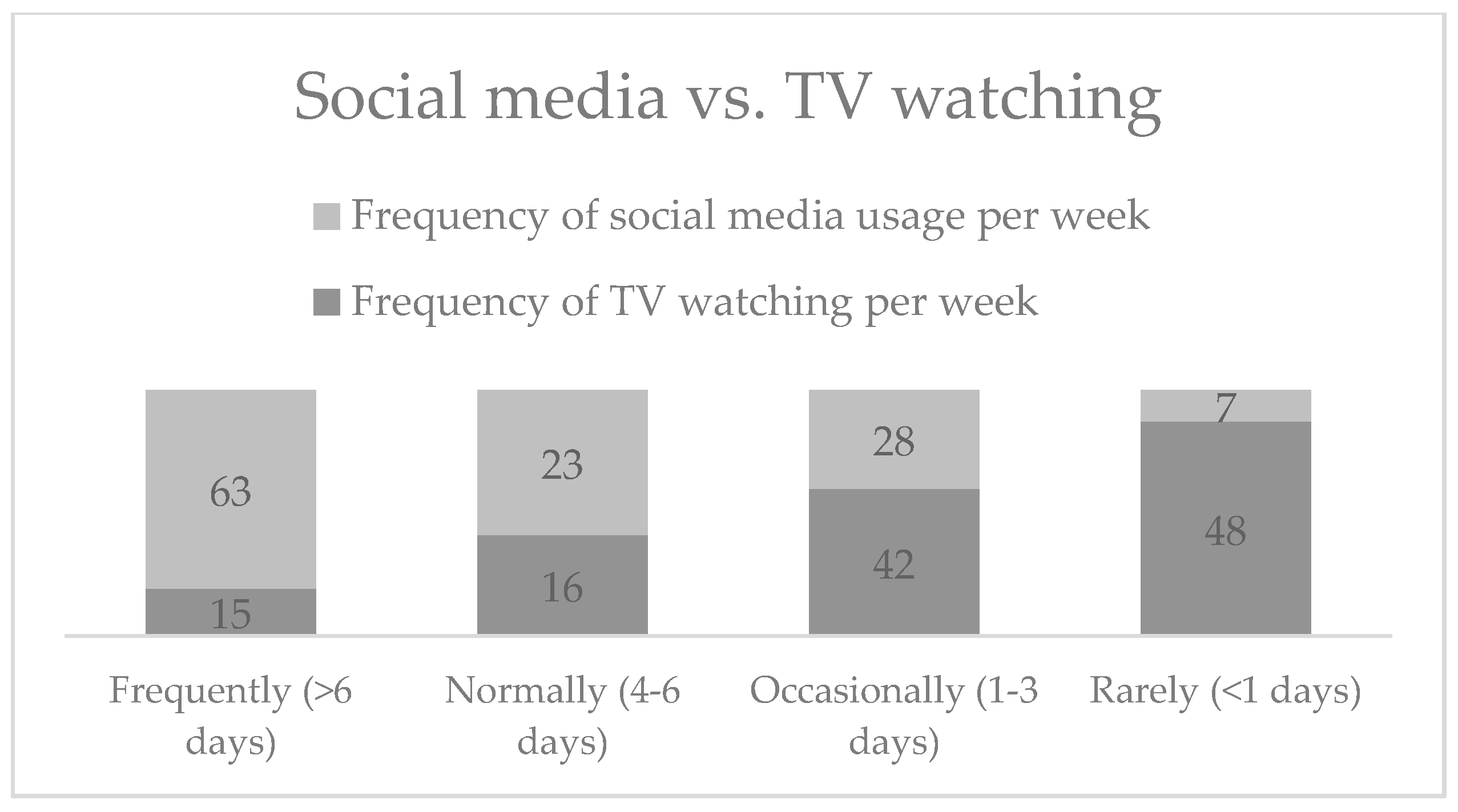
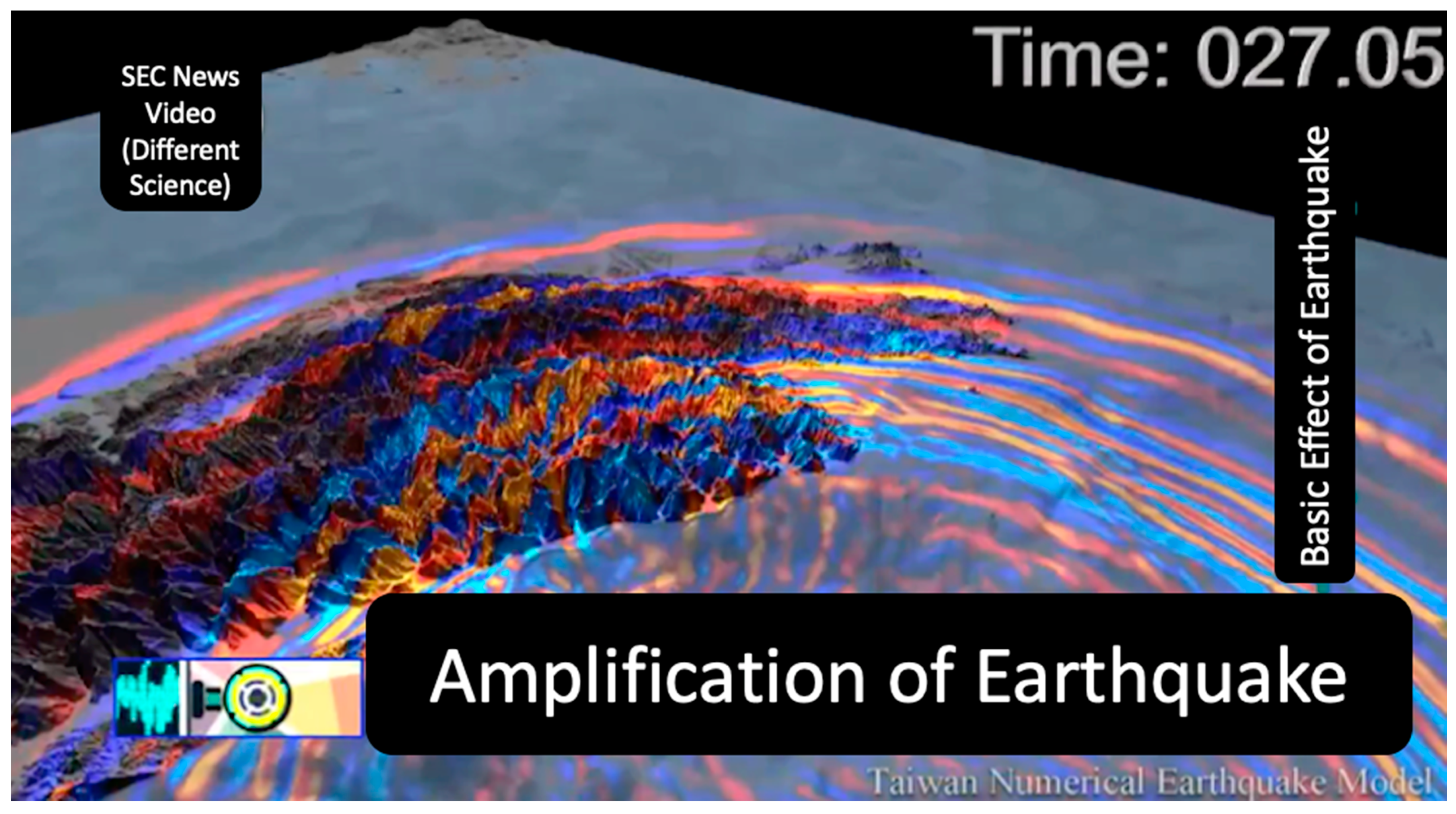
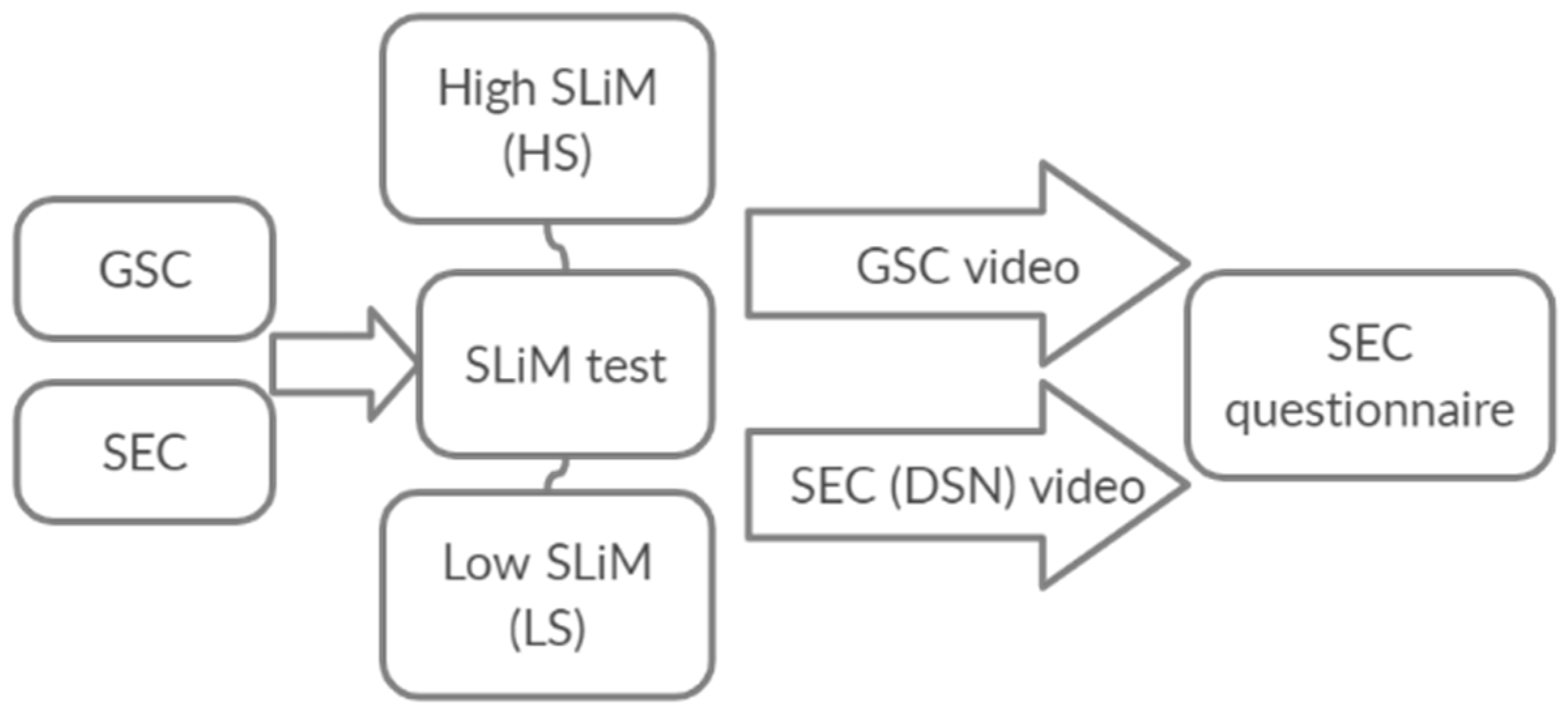
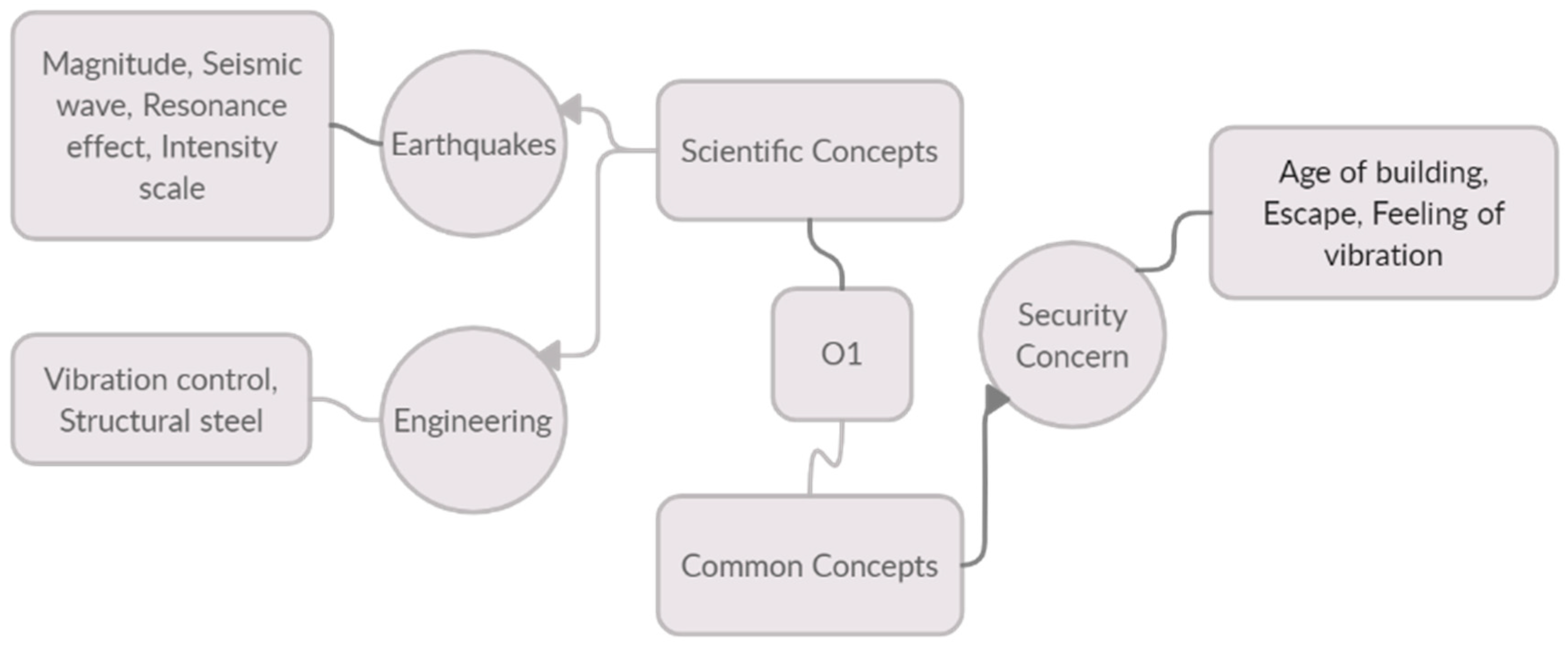

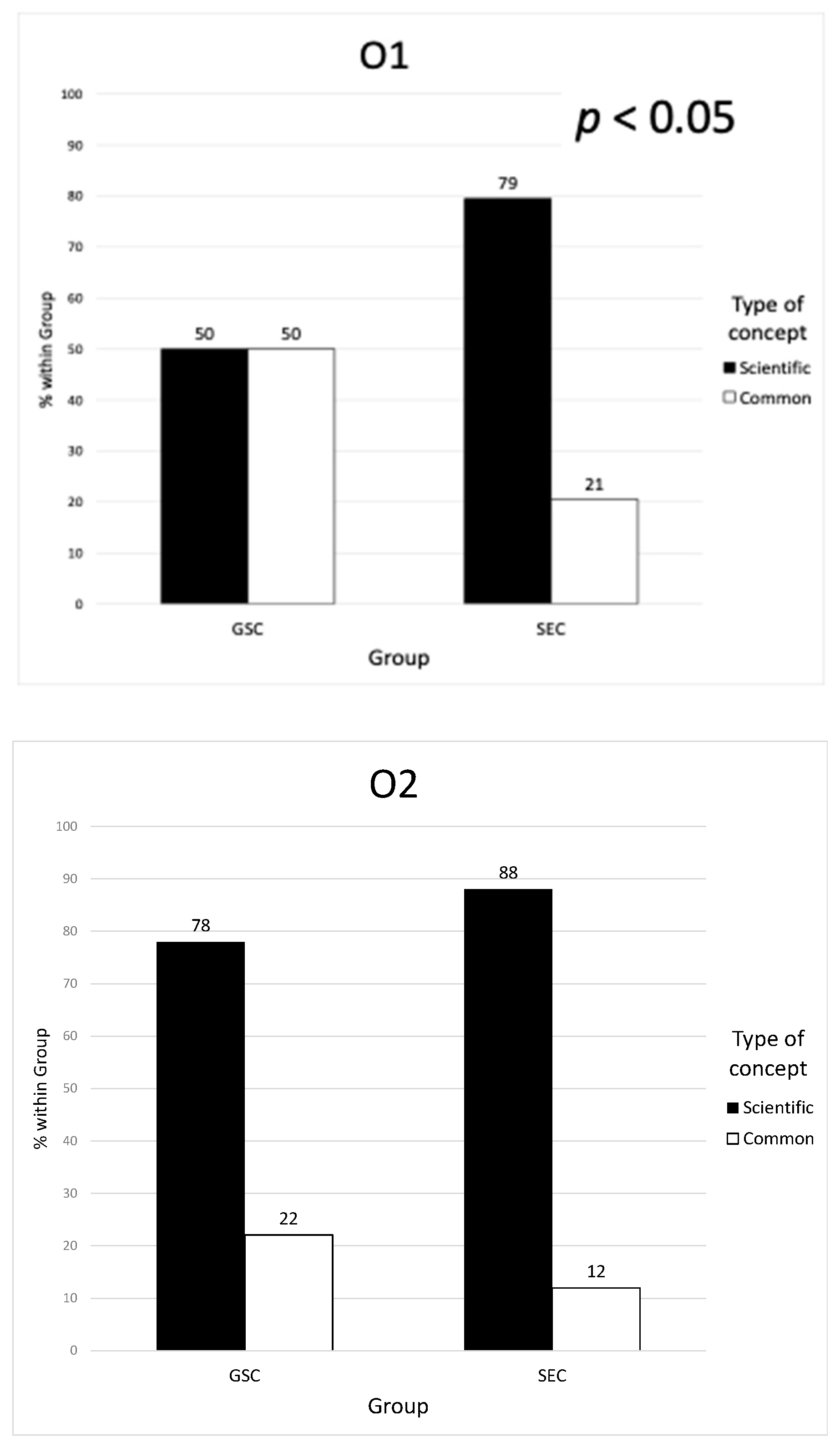
| Measure | Category | Number | Percentage (%) |
|---|---|---|---|
| Gender | Female | 84 | 69.4 |
| Male | 37 | 30.6 | |
| Total | 121 | 100 | |
| Major | Non-science major | 91 | 75.2 |
| Science major | 30 | 24.8 | |
| Total | 121 | 100 |
| Two-Way ANOVA | ||||||
|---|---|---|---|---|---|---|
| SEC (SEC/GSC) Group Effect | SLiM (HS/LS) Effect | Group * H/LS Interaction | ||||
| MS | F | MS | F | MS | F | |
| Awareness | 0.294 | 0.032 | 56.190 | 6.139 ** | 0.006 | 0.001 |
| Enjoyment | 0.290 | 0.093 | 14.781 | 4.766 * | 2.606 | 0.840 |
| Interest | 35.482 | 4.285 * | 131.794 | 15.917 ** | 0.171 | 0.021 |
| Understanding | 16.488 | 13.580 ** | 3.191 | 2.628 | 4.429E-5 | 0.000 |
| Item | Group | Scientific Concept | Common Concept | X2 | ||
|---|---|---|---|---|---|---|
| N | % | N | % | |||
| 1 | GSC (N = 50) | 25 | 50 | 25 | 50 | p = 0.000 |
| SEC (N = 78) | 62 | 79 | 16 | 21 | ||
| 2 | GSC (N = 68) | 53 | 78 | 15 | 22 | p = 0.069 |
| SEC (N = 117) | 103 | 88 | 14 | 12 | ||
Publisher’s Note: MDPI stays neutral with regard to jurisdictional claims in published maps and institutional affiliations. |
© 2020 by the authors. Licensee MDPI, Basel, Switzerland. This article is an open access article distributed under the terms and conditions of the Creative Commons Attribution (CC BY) license (http://creativecommons.org/licenses/by/4.0/).
Share and Cite
Wu, L.Y.; Wu, S.P.; Chang, C.-Y. Teachable Moments in News Media—An Analysis of Audience Awareness, Enjoyment, Interest, Opinion Formation, and Understanding (AEIOU) toward Science. Sustainability 2020, 12, 10212. https://doi.org/10.3390/su122310212
Wu LY, Wu SP, Chang C-Y. Teachable Moments in News Media—An Analysis of Audience Awareness, Enjoyment, Interest, Opinion Formation, and Understanding (AEIOU) toward Science. Sustainability. 2020; 12(23):10212. https://doi.org/10.3390/su122310212
Chicago/Turabian StyleWu, Leon Yufeng, Shannah Pinhsuan Wu, and Chun-Yen Chang. 2020. "Teachable Moments in News Media—An Analysis of Audience Awareness, Enjoyment, Interest, Opinion Formation, and Understanding (AEIOU) toward Science" Sustainability 12, no. 23: 10212. https://doi.org/10.3390/su122310212
APA StyleWu, L. Y., Wu, S. P., & Chang, C.-Y. (2020). Teachable Moments in News Media—An Analysis of Audience Awareness, Enjoyment, Interest, Opinion Formation, and Understanding (AEIOU) toward Science. Sustainability, 12(23), 10212. https://doi.org/10.3390/su122310212






